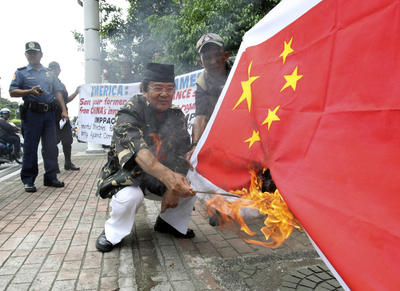The Philippines is currently drawing up a list of seven incidents for submission to the UN, alleging Chinese violation of its sovereignty.
Six nations are currently involved in territorial and maritime disputes in the South China Sea: China, Taiwan, Vietnam, the Philippines, Malaysia and Brunei. In 2002, the four Southeast Asian states, acting through ASEAN, negotiated a modus vivendi with China. This took the form of a Declaration on Conduct of Parties in the South China Sea (DOC). The DOC was nothing more than a political statement. Its signatories agreed to settle their disputes peacefully and not to upset the status quo. The parties also agreed that the DOC would be the first step towards a more binding Code of Conduct (COC).
In May 2009, China protested when Malaysia and Vietnam made separate and joint submissions to the UN Commission on the Limits of the Continental Shelf. China countered by tabling, for the first time, a map outlining its claims to the South China Sea. China’s map contained nine dash lines in a u-shape covering an estimated 80 per cent or more of the maritime area. The claims appeared to have little basis in international law. The incidents that have occurred this year all appear to result from China’s efforts to exercise jurisdiction within the nine dash lines.
China has relentlessly increased its capacity to exercise control over the Sea by expanding the number of ships active under the China Maritime Surveillance and China Fishery Administration agencies. At the same time, China has increased the capacity and capability of the People’s Liberation Army Navy South Sea Fleet, particularly by constructing a naval base at Sanya on Hainan Island.
China’s assertiveness in the South China Sea over the last four years has resulted in Vietnam’s decision to modernise its navy by acquiring modern guided missile frigates and six Kilo-class conventional submarines. The Philippines too has announced modest plans to increase its capacity for territorial defence in its maritime domain. But Southeast Asia’s four claimant states, alone or together, cannot hope to match China’s naval power.
Instead, Southeast Asia claimant states seek to resolve territorial disputes with China on a multilateral basis under the auspices of ASEAN. They are proceeding on two tracks. The first track involves reviving the ASEAN-China Joint Working Group’s until-now moribund discussions on implementing the DOC and negotiating guidelines for its implementation. The two sides are currently considering the twenty-first draft. The major sticking point is paragraph two, which provides for ASEAN to caucus before meeting with China. One alternative proposal is to remove this paragraph and adopt its spirit by verbal agreement; another is for the claimant states to meet first, then caucus with ASEAN and finally meet with China.
China insists that territorial disputes be settled by the countries directly concerned. China opposes multilateral discussions because, it argues, territorial disputes in the South China Sea are not between China and ASEAN. China also outright rejects the involvement of outside powers — read the US — in any settlement.
ASEAN claimants counter-argue that outside powers are legitimate stakeholders when it comes to broader issues affecting stability and security in the Sea. Not surprisingly, ASEAN welcomes the involvement of the US and other maritime powers that have interests in the Sea. But ASEAN is wary of ganging up on and isolating China.
China and ASEAN are in the advanced stages of separate negotiations on the text of a Code of Conduct to govern the behavior of states in the South China Sea. The difference between the DOC and COC is that the latter is supposed to be more binding. But unless it has treaty status it is unclear how a COC can be enforced. ASEAN and China are reportedly aiming to adopt the COC next year at the ASEAN Summit in Phnom Penh on the tenth anniversary of the DOC.
The next five months will be crucial. In July, ASEAN commences its diplomatic season by holding a series of summits. These include the ASEAN Regional Forum in July and the East Asia Summit in November where the United States will be present for the first time. China is likely to come under intense diplomatic pressure to strike a deal with ASEAN. But no final settlement on territorial disputes can be reached until China revises its claims to the South China Sea to conform to international law including the United Nations Convention on Law of the Sea.
Carlyle A. Thayer is Emeritus Professor, The University of New South Wales at the Australian Defence Force Academy, Canberra.

